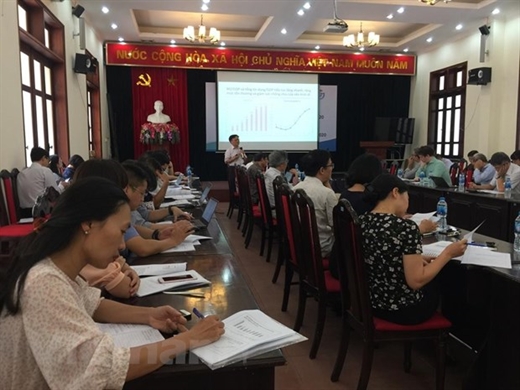Australia supports Economic Reform in Vietnam (Aus4Reform)
- en
- News and Media
- Aus4Reform News
- The economic growth rate in 2016-2020 has improved, but not reached the strategic goal
18/9/2019
The economic growth rate in 2016-2020 has improved, but not reached the strategic goal
This is the opinion of Dr. Nguyen Dinh Cung presented at the Workshop announcing the research report ‘Evaluation Report on economic restructuring, changing the growth model for the 2016-2020 period’, organized by CIEM within the framework of the “Australia supports Vietnam's economic reform (Aus4Reform) Program” on the morning of September 17.
The economic growth rate in 2016-2020 has improved, but not reached the strategic goal
This is the opinion of Dr. Nguyen Dinh Cung presented at the Workshop announcing the research report ‘Evaluation Report on economic restructuring, changing the growth model for the 2016-2020 period’, organized by CIEM within the framework of the “Australia supports Vietnam's economic reform (Aus4Reform) Program” on the morning of September 17.
The report evaluates the results on a number of contents, such as: Macroeconomic stability and strengthening the resilience of the economy; growth and manner and quality of growth; restructuring (investments, credit institutions and state-owned enterprises).
The report shows that Vietnam has achieved some commendable achievements. GDP per capita in 2018 reaches VND 58.5 million and is 1.85 times higher than in 2011. Besides, the average GDP growth rate for the 3 years from 2016 to 2018 is 0.8% higher than that of 5 years 2011–2015. Of which, service growth is higher than 0.47 percentage points, industry and construction are higher than 0.92 percentage points, but agriculture, forestry and fishery increase by 0.45 percentage points compared to 5 years ago.
 |
Yet the economy is still vulnerable. The reason is that the growth rate of monetary supply and credit are still high, increasing steadily over the years, such as the ratio of debit balance / GDP has increased from over 105% in 2011 to 133.9% in 2018; public debt is still high ... In addition, the improvement in labor productivity, investment efficiency is low; The contribution of the state economy to the growth declines significantly, the efficiency of capital use is not high ...
Regarding shift in economic structure, PhD. Nguyen Dinh Cung, former president of CIEM, said that the restructuring of the economic sector shows that the role of the private economy has increased remarkably, but it has stopped at a very small level and only equal to half compared to the FDI sector. Moreover, the state economic sector has declined sharply with almost no change in management capacity, even less and less.
Regarding economic restructuring, Mr. Cung said that the restructuring programs are generally being conducted more slowly than required. Restructuring credit institutions have achieved some clear results in dealing with bad debts, but the restructuring of public investment and state-owned enterprises has not made progress in quality, and is still carried out in formal rather than implement strong and effective measures.
It can be said that, because Vietnam shifted its focus on reform and administration of socio-economic development in the period of 2011-2015, efforts and resources mainly focused on macroeconomic stability and economic production and business recovery, economic growth have prospered.
However, to look frankly, the Vietnamese economy have not had a breakthrough. The growth rate is still low compared to the strategic goal, the productivity and efficiency improvement is still low compared to the demand for high and sustainable growth and the need of shifting to the deep growth model. Contribution of economic sectors to growth is basically unchanged, the structure of the economy is "rigid, less dynamic", which leads despite a certain improvement in productivity and efficiency, the growth model has basically not changed. The growth rate, the level of improvement in labor productivity, capital efficiency, ... are still low with the need to narrow the development gap and keep pace with developed countries with high incomes.
From the above issues, to overcome the limitations of restructuring the economy, successfully transforming the growth model, Dr. Nguyen Dinh Cung said that it is necessary to have a comprehensive system of solutions from the whole for the whole economy to the solutions for each industry, field and region and locality, and it is necessary to overcome the division and lack of connectivity, lack of complementarity between economic sectors and economic restructure must become more dynamic. In addition, we need solutions to overcome the economic imbalance, make the domestic private sector develop faster and more uniformly, leading to the main driving force for national economic development.
At the same time, the experts attending the workshop also proposed that solutions should be put in the context of global changes in technology and world economic fluctuations. Economic expert, PhD. Le Dang Doanh said that the restructuring of the economy must not only be in the context of integration but also must be placed in the context of fierce international competition, because we participate in many FTAs, all commitments must be implemented clearly and transparently.

